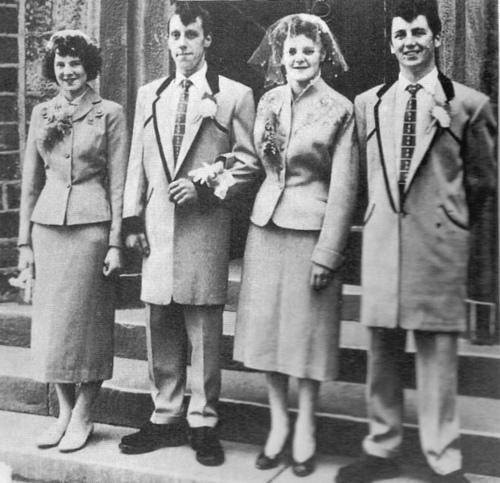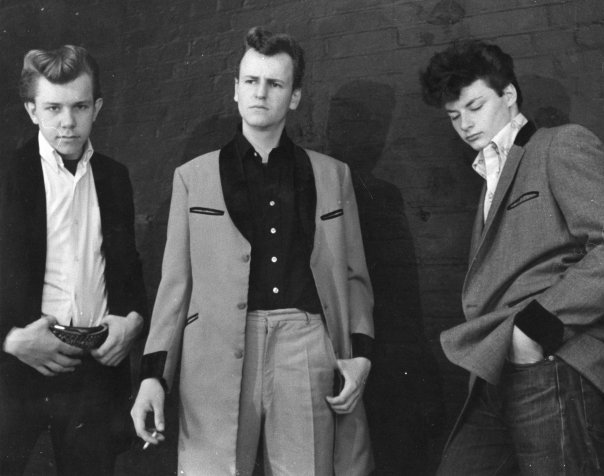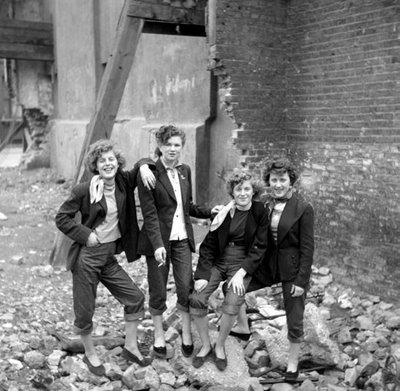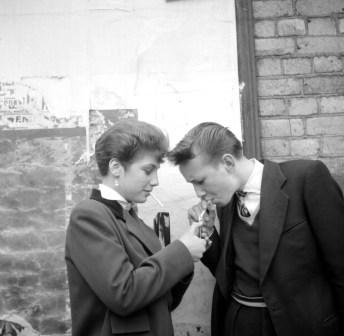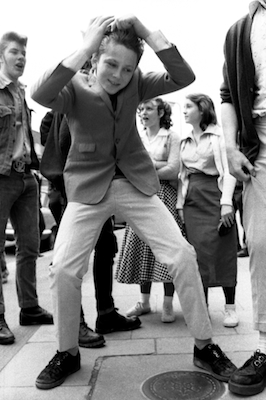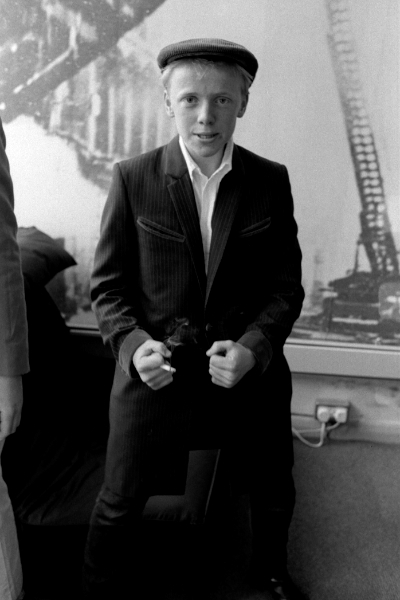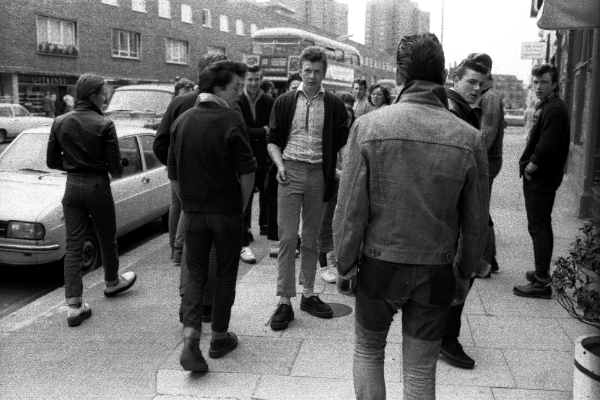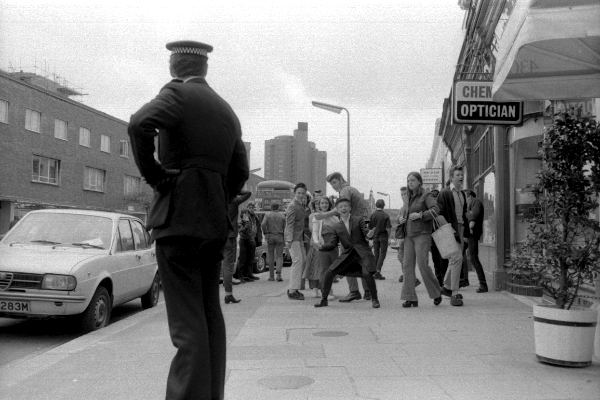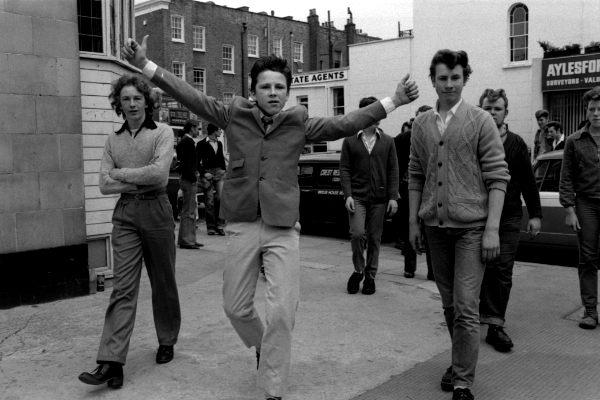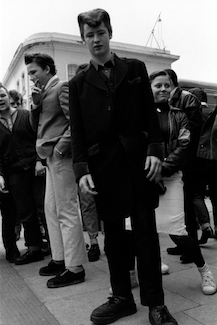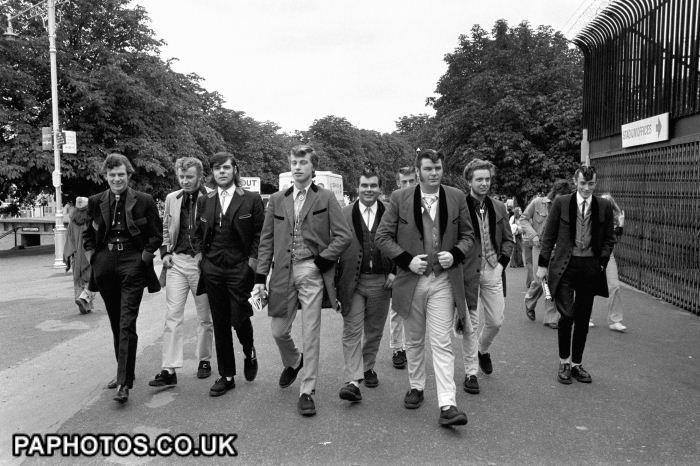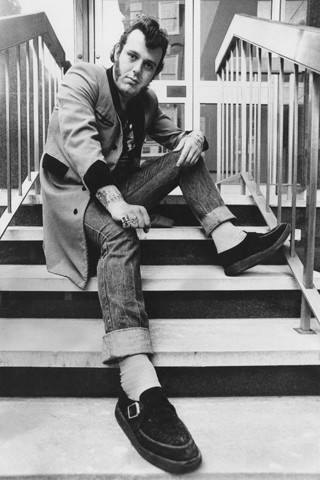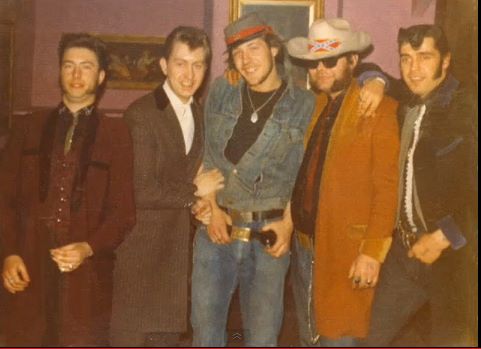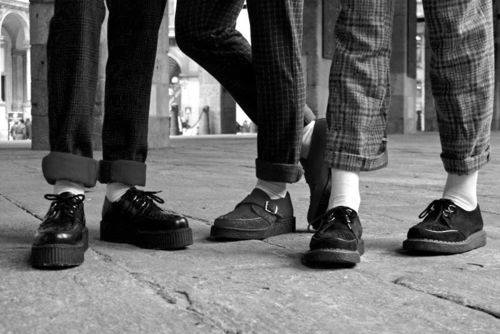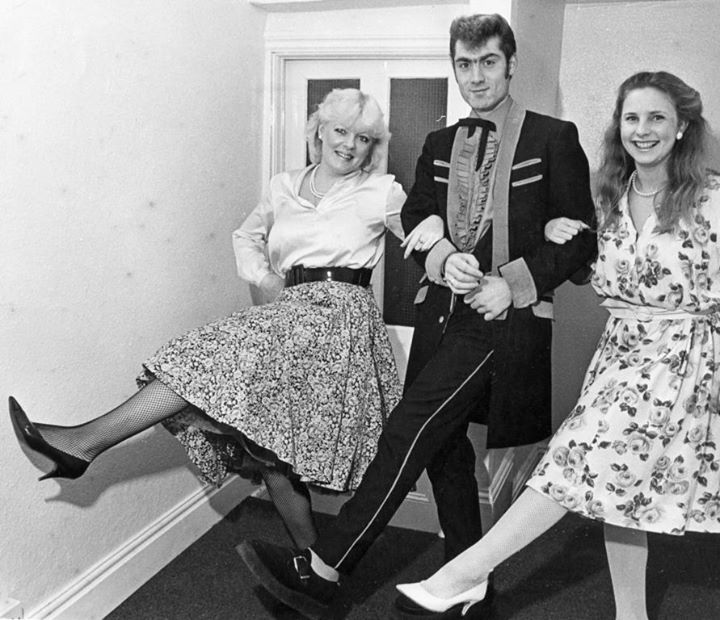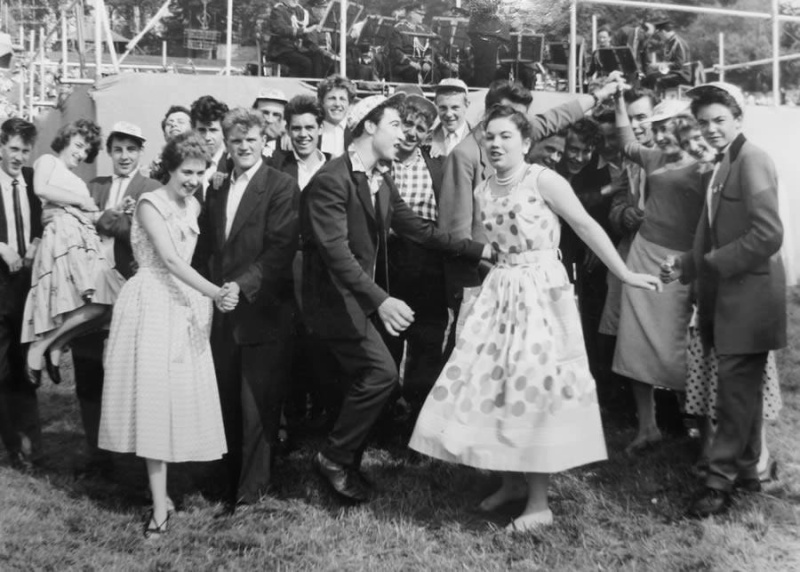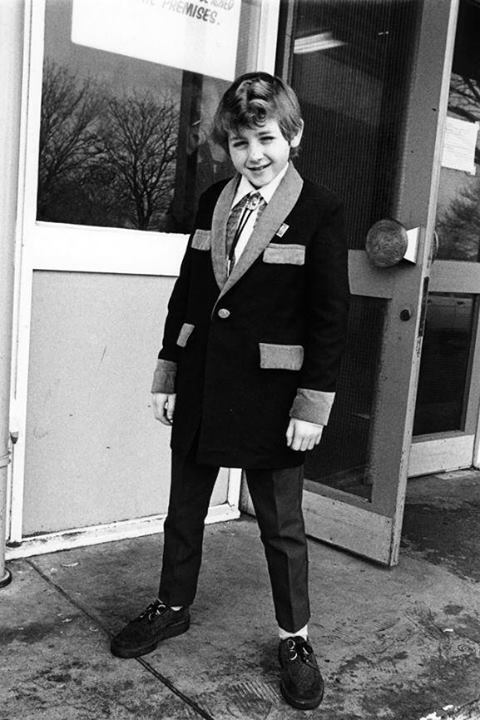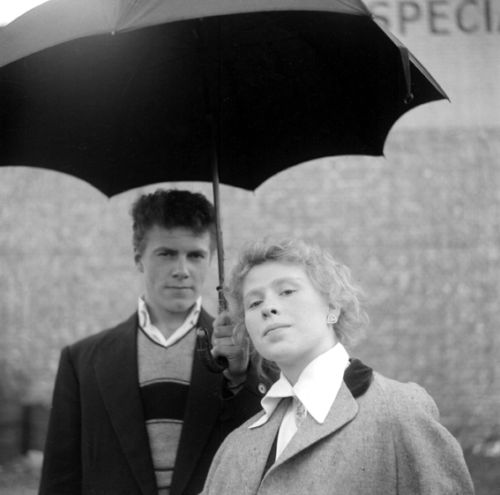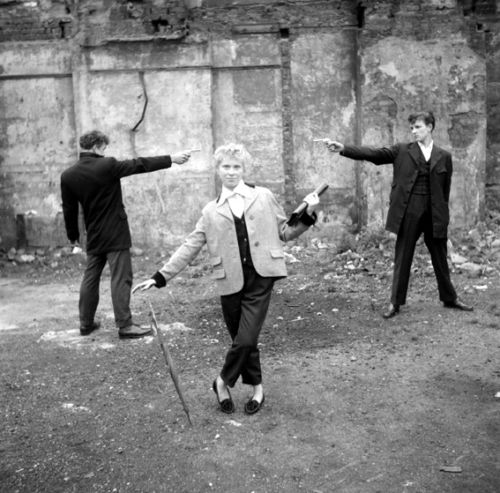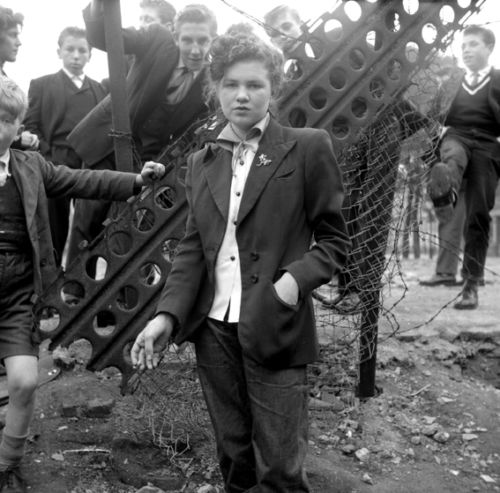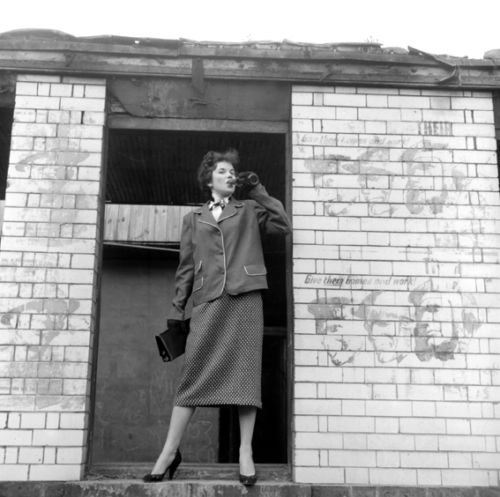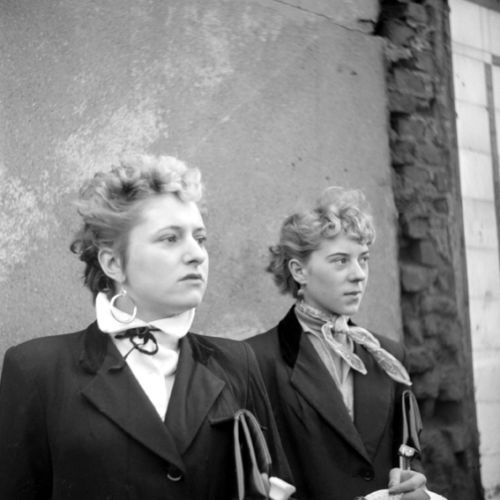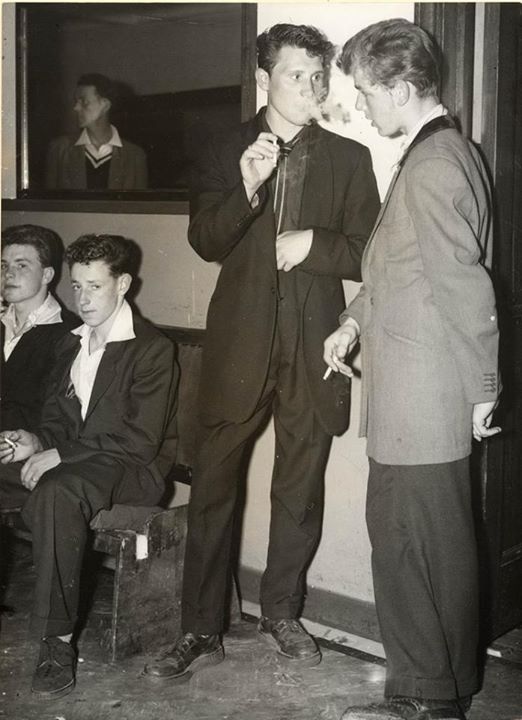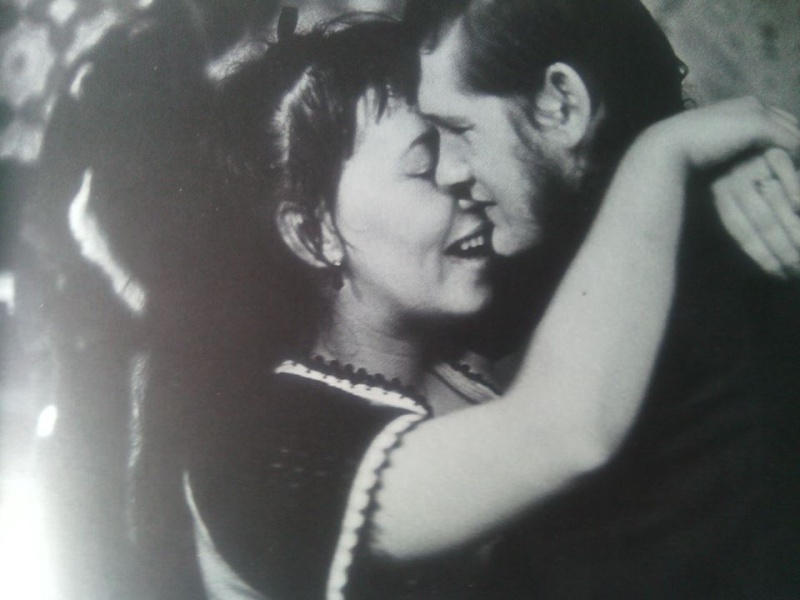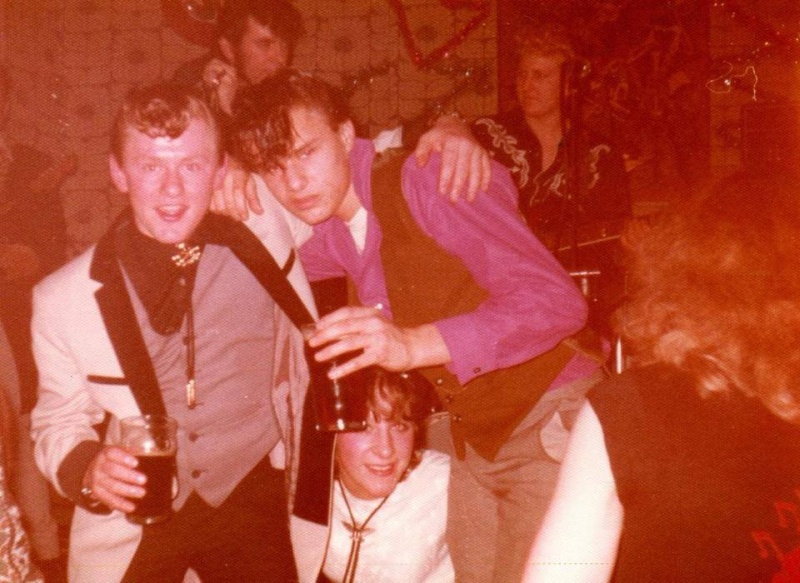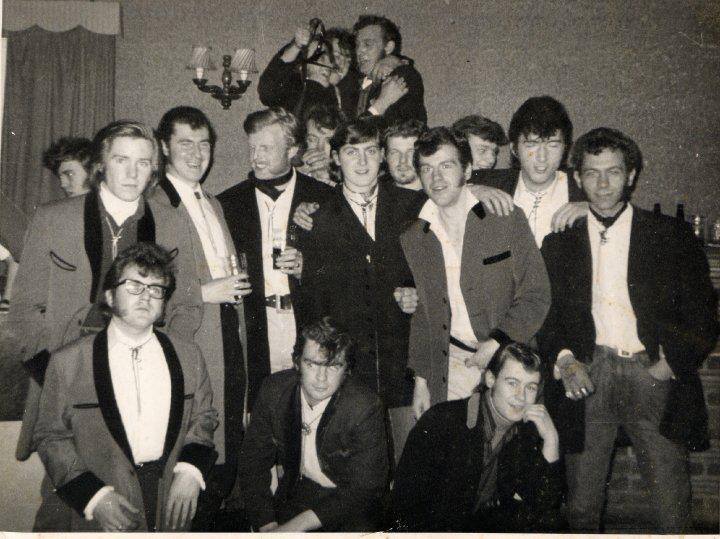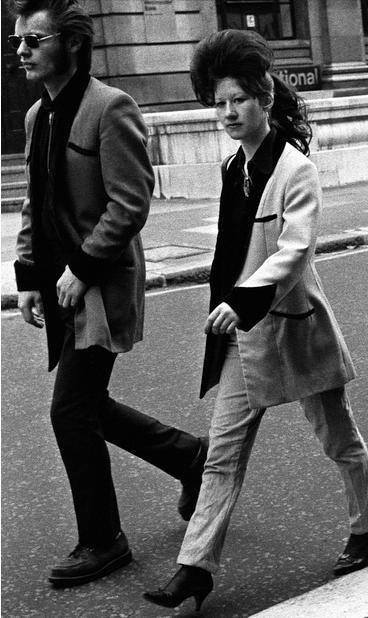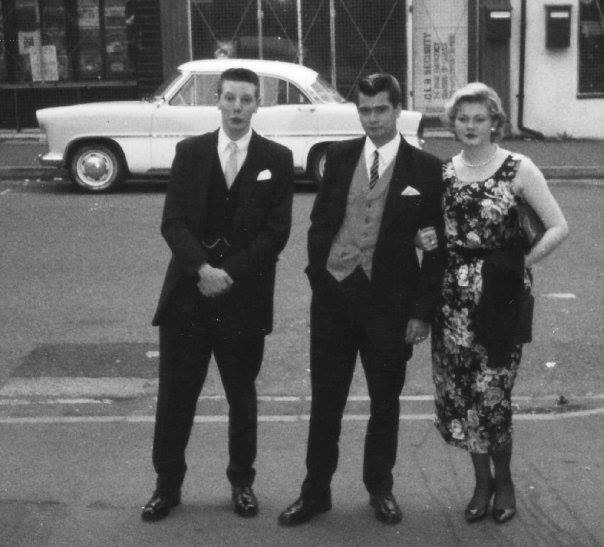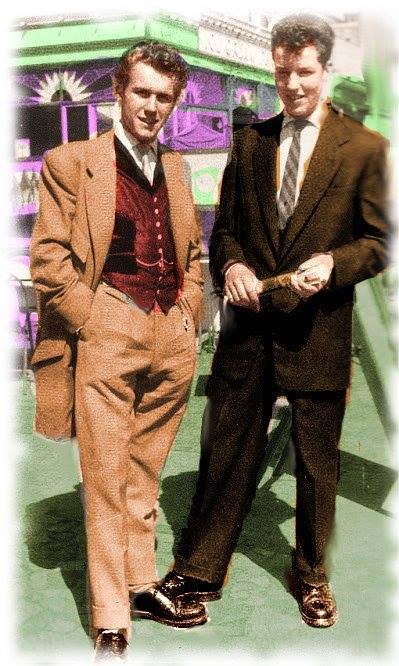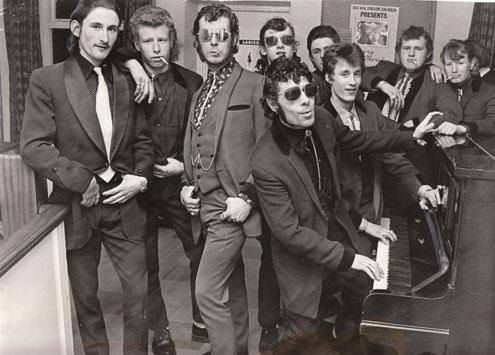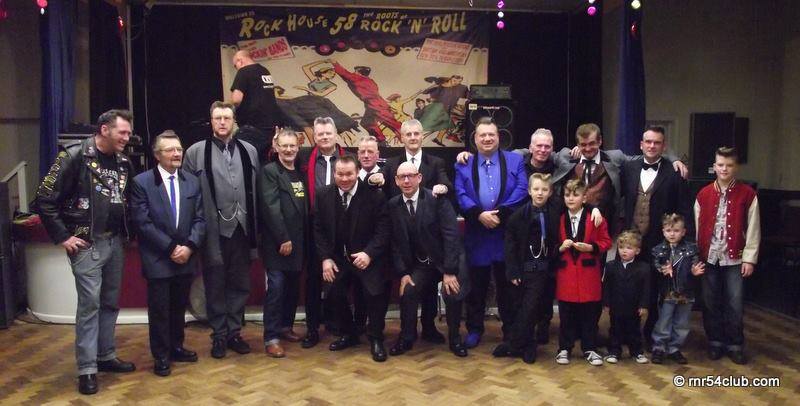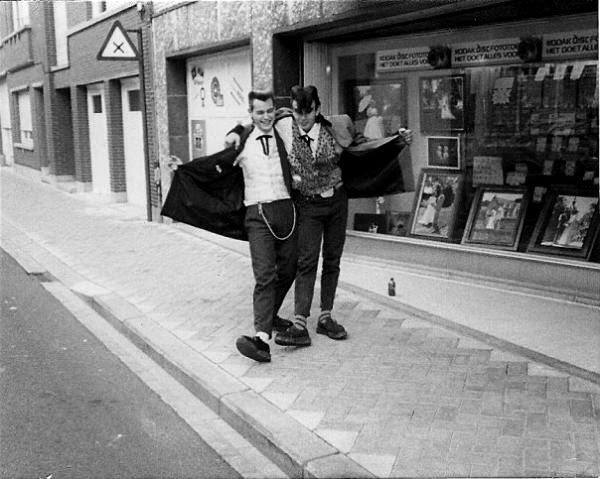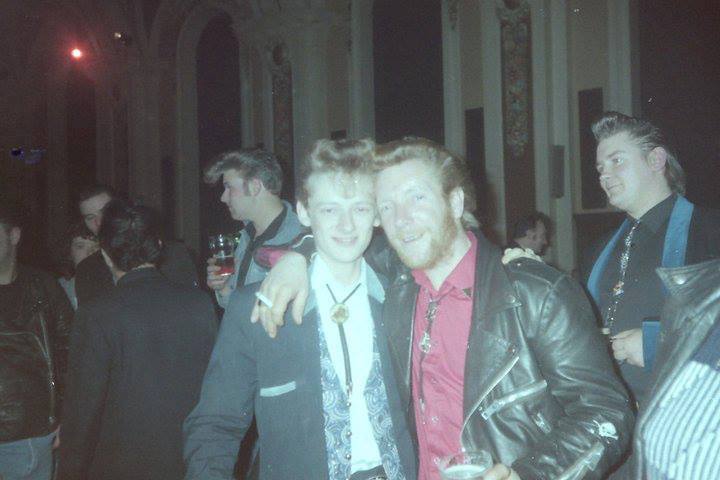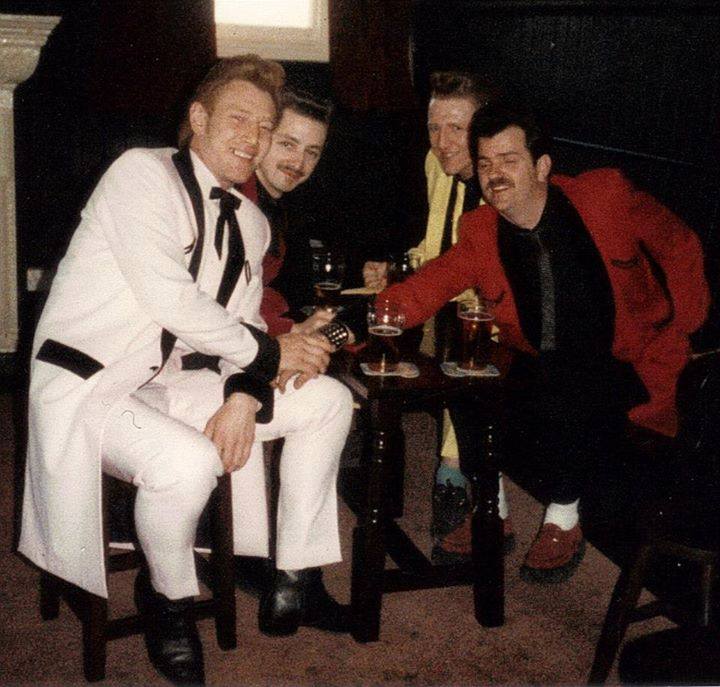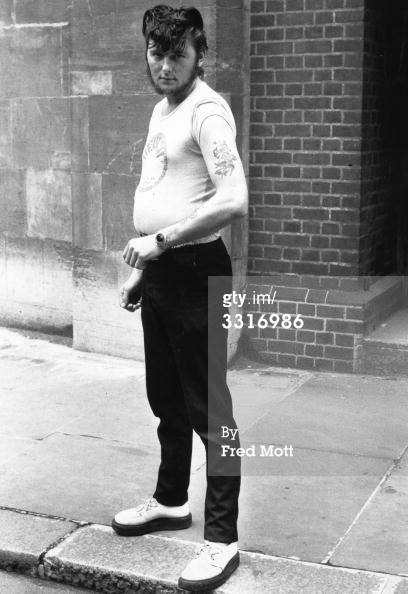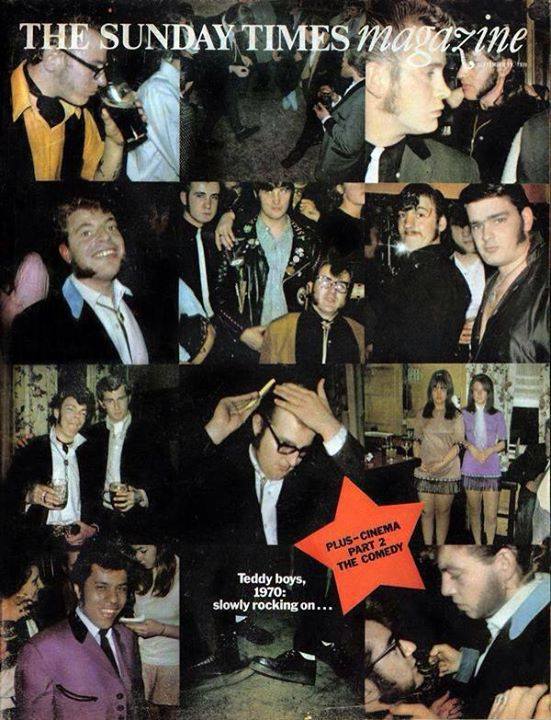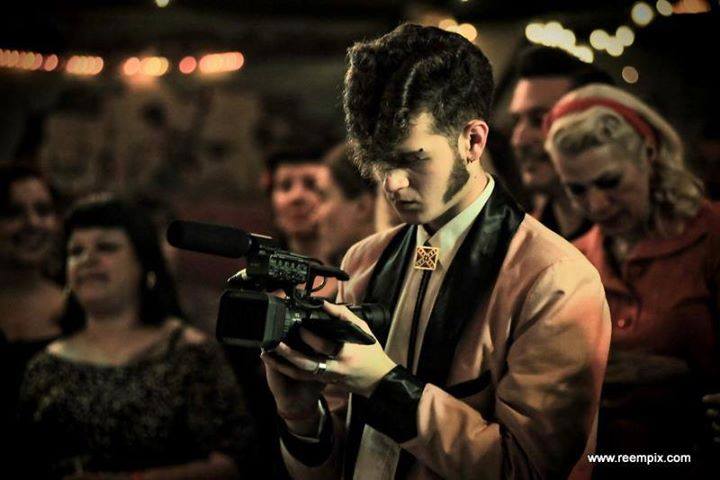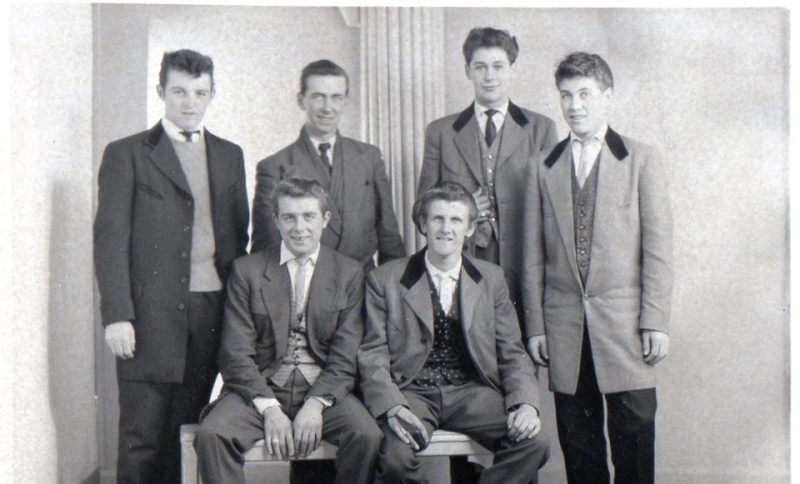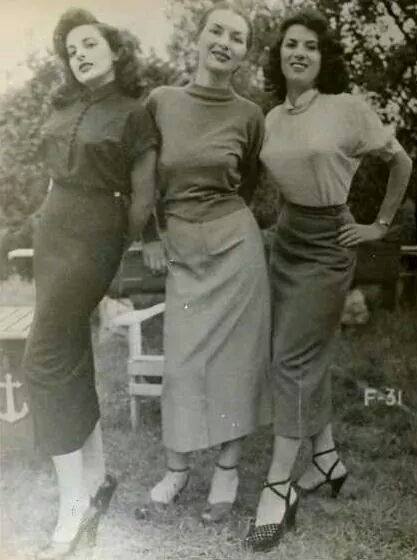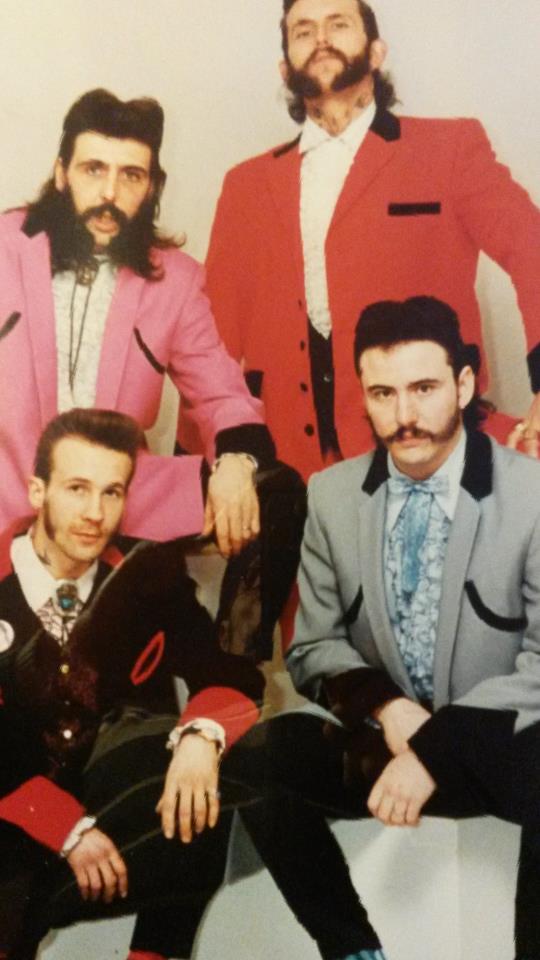Teddy Boys
4 participants
Page 1 sur 6
Page 1 sur 6 • 1, 2, 3, 4, 5, 6 
 Teddy Boys
Teddy Boys

Teddy Boys Londres 1962
Le mouvement Teddy Boy commence en Grande Bretagne dans les années cinquantes représentant l'une des première culture de la jeunesse britannique. On l'associe en général avec l'arrivée du rock américain sur les Iles britanniques, mais en réalité il semble que les teddy boys coïncident plutôt avec l'arrivée d'un style musical qui fait fureur au milieu des 1950's en Grande Bretagne le Skiffle (style qui musicalement est un cousin du rockabilly américain, mais sans avoir aucun lien avec ce dernier (voir les articles sur le sujet).
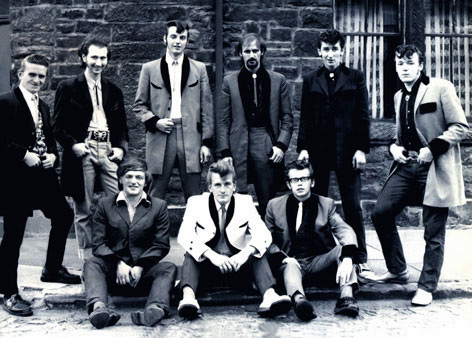
Teddy Boys 1976
Le look des Teddy boys est ce que l'on appelle Edwardian style soit un drape jacket (veste longue), suede Gibson shoes avec des semelles crêpes (qui seront remplacées par les Creepers), des pantalons "drainpipe', des chemises extravagantes (quelques fois chemises à jabots) quelques fois avec un gilet par dessus, et autour du col de la chemise une cravate lacets. L'arme préférée des Teds était le rasoir à main des barbiers, et
quelques fois placé des lames de rasoirs derrière leurs cols lorsqu'un adversaire tentait de l'attraper par là.
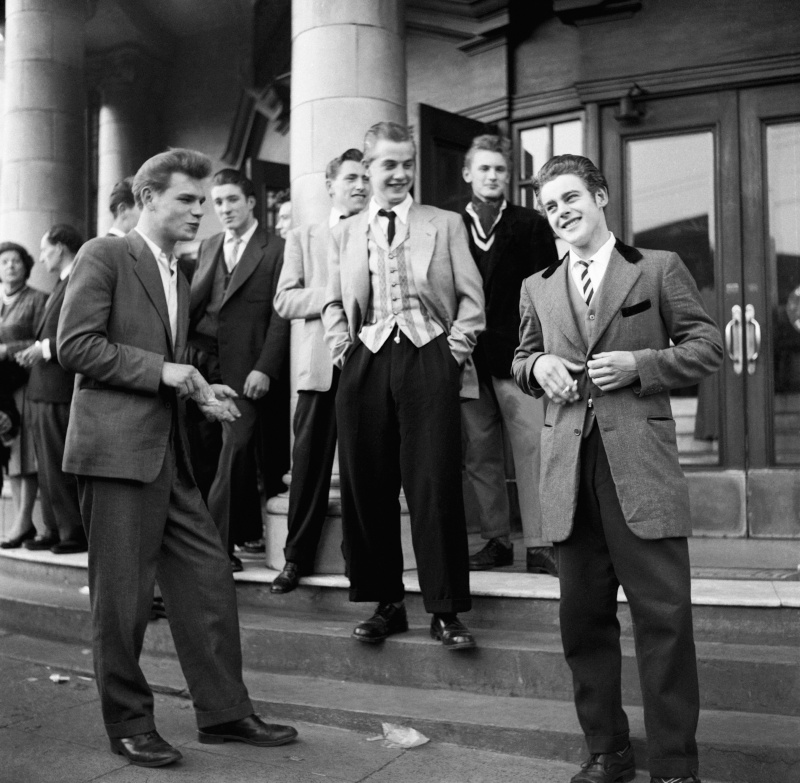
Teddy Boys around 1955
Les Teddy girls ont le look typiques des femmes des années 1950 soit des pantalons corsaire ou des jupes ou robes de types parapluie qui tourne en cercle lors de rock n'roll endiablés faisant apparaître les jambes. Au niveau de la coiffure les tedy girls ont souvent des queue de cheval et les teddy boys des Pompadours (bananes en français) avec une ducktails (les cheveux qui se croisent derrière la tête (coiffure typique des rockers américains à partir de 1958)
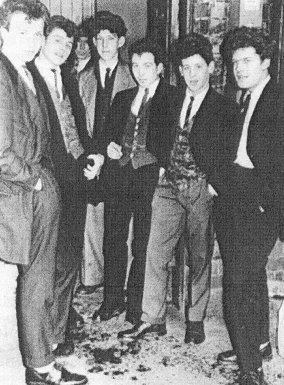
Teddy Boys. To many parents they represented the anti-Christ. To many teenage lads they were everything you wanted to be but did not dare. (Express & Star)
Bien évidemment les Teddy Boys adoptent le rock n'roll américains dés son arrivée en Grande Bretagne.
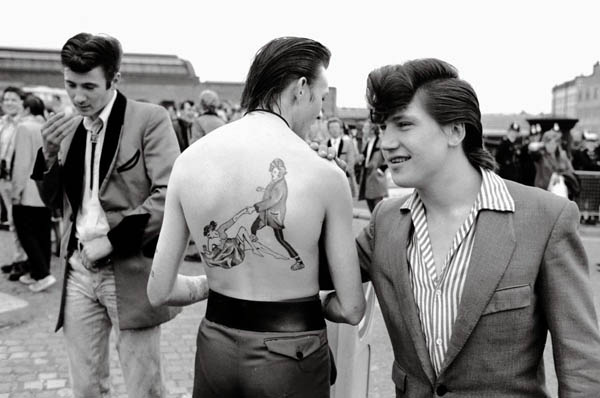
Wembley 1972
Le mouvement qui né à Londres envahit rapidement la grande Bretagne, de nombreux gangs se forment ayant quelques fois des détails de reconnaissance la couleur des drapes jackets ou des chaussettes.
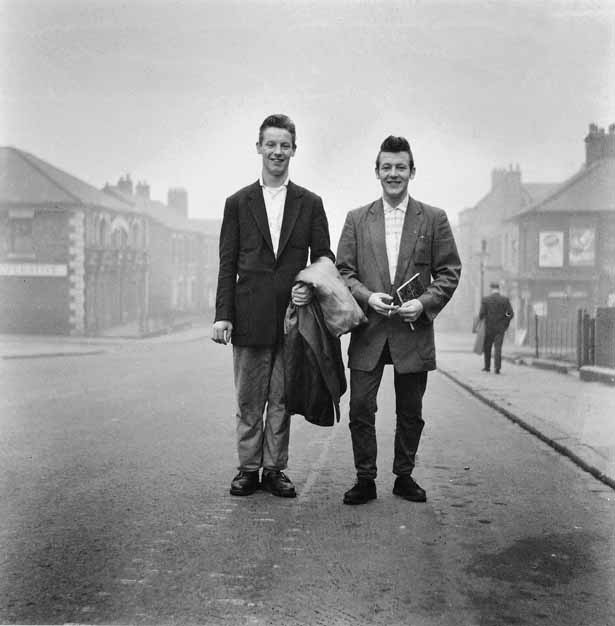
scottswood teddy boys by jimmy forsyth, 1957
Quelques actes de vandalismes furent exagérer par les médias et le Teddy boys devient synonyme de délinquants, quoiqu'il y eut de grosses altercations entre gangs.

Teddy Boys & Girls, 1955.
Au contraire de certaines idées reçues il n'y a pas d'idéologies politiques ci ce n'est un culte au rock n'roll, même si on peut noter des gang Teddy boys avec des tendances anarchistes qui se battent violemment avec des jeunes néo nazis au milieu des 1950's et d'autres s'affrontèrent avec des jamaïcains lors des émeutes de Nothing hill en 1958.
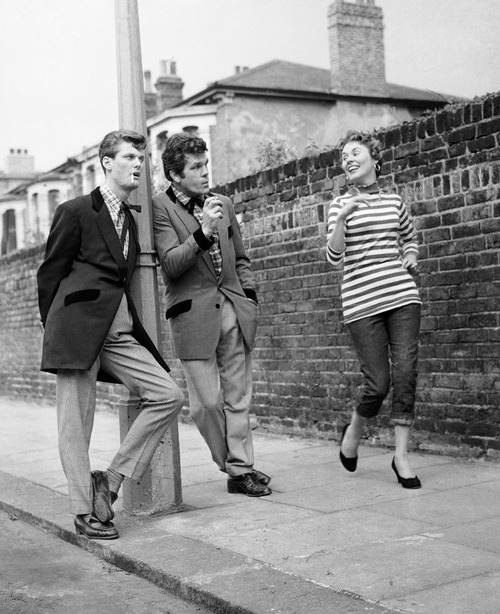
Teddy Boys 1956
Mais cela reste anegdotique à Nothing Hill il s'agit dans ce cas de batailles rangées entre des gangs habitant des quartiers populaires dont certains étaient des teddy boys et d'autres des noires mais aucune idéologie derrière.

Teddy Boys on Princedale Road, London, 1956
Photograph by Roger Mayne
Mais un essai de récupération des faits d'un côté politique comme de l'autre (ce qui est toujours le cas de nos jours).
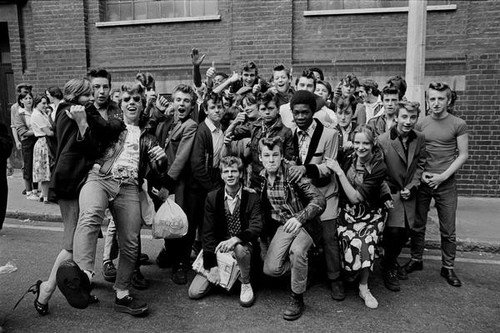
Teddy boys 1977
Durant les sixties les Teddy boys sont remplacés par les Rockers qui roulent en motos anglaises coursifiées en Cafe racer et portent jean et blousons de cuir noir se rapprochant de leurs cousins américains roulant en Harley Davidson.
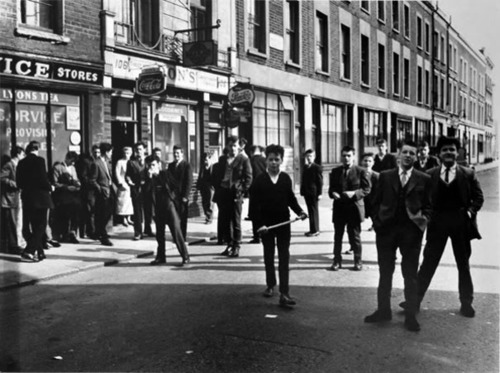
Teddy Boys, North Kensington
Et c'est à la fin des sixties et début des seventies que le mouvement revient sur le devant avec un retour du rock n'roll originel (voir les films sur le London Rock n'roll show) et c'est le début d'un nouveau style musical le teddy Boy rock n'roll et rockabilly avec des groupes comme Crazy Cavan, Matchbox, Riot Rockers, Flyin' saucers et Wild Angels pour les plus célèbres.

Teddy Boys 1978
Dans les années 80, c'est le "rockabilly boom" lancé à la fin de la decennie précédente par les groupes teddy boys en Europe, voit l'arrivée de nouveau style de fans de rock n'roll les Rockabilly Rebels qui naissent grâce essentiellement aux tubes de Matchbox du même nom ils adoptent les blousons teddy et les Creepers, sortent de pont entre le look des jeunes américains des fifties vu dans des films comme Américan graffiti et les teddy boys, et les néo rockabillys qui soutiennent les nouvelles formations comme les Stray Cats, Polecats, Phantom rockers sharks, Restless et Meteors ont un look a mi- chemin entre les fifties et le punk qui débouchent pour certains sur le Psychobilly.
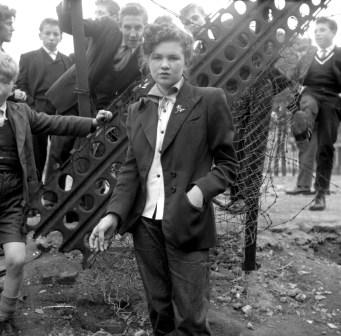
Teddy Boys and Girl - 1950's
Dans les années 90 les Teddy boys deviennent une antitée autonome au niveau du rock n'roll international avec ses festivals, ses labels et ses groupes (dont on peut citer 2 des plus célèbres les Teencats et les black knights), avec au niveau du monde du rock n'roll un retour au rock n'roll et rockabilly authentique et de la culture hot rod vintage.
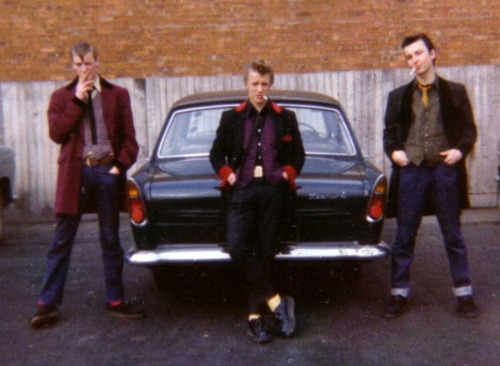
Teddy Boys, 1976
Aujourd'hui le mouvement se porte trés bien, perpétuant ses codes et sa culture jusqu'à nos jours avec de nouvelles générations de fans.
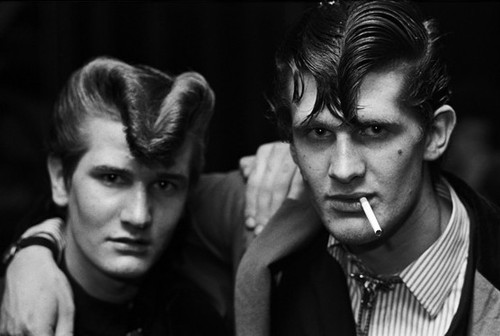
Teddy Boys 1970's
 Re: Teddy Boys
Re: Teddy Boys
_________________
We don't care the People Says , Rock 'n' roll is here to stay - Danny & the Juniors - 1958
 Re: Teddy Boys
Re: Teddy Boys
_________________
We don't care the People Says , Rock 'n' roll is here to stay - Danny & the Juniors - 1958
 Re: Teddy Boys
Re: Teddy Boys
Ce petit historique me parait aussi bien fait:
The Story Of The Teddy Boy Movement
All began in the early 1950's in England. Some teenagers gangs appeared in the East End of London; they were called the Cosh boys. It was very easy to recognise them. They wore a very special rig : long jacket with velvet collar and cuffs drain-pipe trousers like under the reign of Edward VII (1901-1910), bright ankle socks and slim Jim tie. There hair were "long" and greased. These Cosh boys terrified the English society : razor attacks, fights between gangs but also against the police, robberies ... After the Second World War England woke up with an headache ! Press needed a new term to describe these gangs which number increased each day? The word chosen was Teddy Boy(s) and Teddy Girl(s), Ted(s)
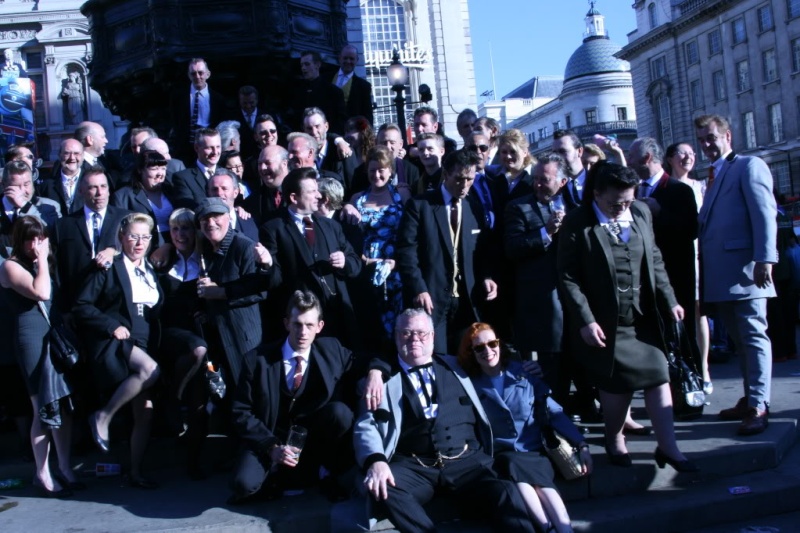
It seems that the first newspaper that used the term Teddy Boy was the Daily Express on September 23rd 1953. At this epoch, Elvis Presley was just a truck-driver!
And then, came Rock'n'Roll immediately adopted by the young generation and of course by the Teds. Bill Haley, Elvis, Buddy Holly, Eddie Cochran, Gene Vincent, Jerry Lee Lewis, Little Richard, Chuck Berry, and British artists like Tommy Steele, Cliff Richard and the Drifters (then the Shadows), Billy Fury, Marty Wilde (and many many others ... ) became the teenagers' idols. It was the beginning of something new, a wind of freedom. In Britain, in September 1956, Bill Haley had 5 records in the 'Top 20' and the film Rock Around The Clock was shown at 300 cinemas, but, in the early 60's, the tastes of the public changed and many Teds, after the military service in the British Army, put away their finger-tip drapes, their tightly fitting trousers and cut their hair. Was it the end of the Teds' culture ? Not at all ladies and gents!
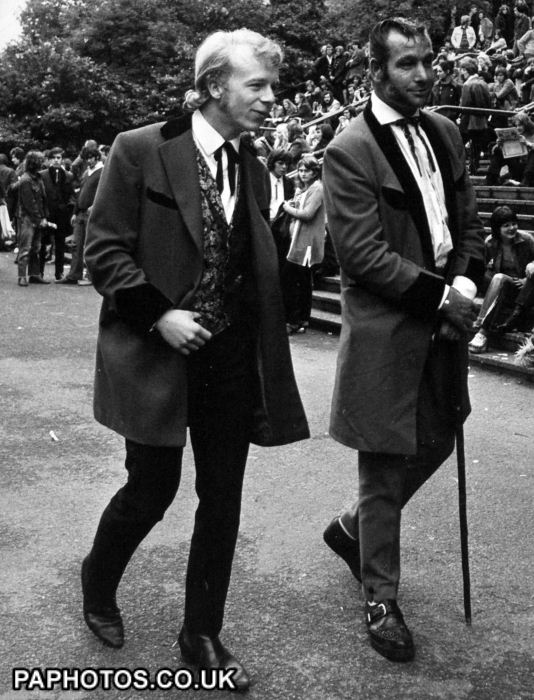
50's R'N'R still had many fans in Great Britain ; many of them, the (Ton-Up) Rockers wore the "uniform" of the "American bad boys" : black leather jackets, T-shirts, jeans and motorcycle boots.
In 1967, Bill Haley's Shake, Rattle and Roll crept into the British charts again. At the end of the 60's, some bands played authentic R'N'R for a new generation of Teds which joined the original ones . Bands like the Wild Angels, the Houseshakers, the R'N'R Gang (in France), Shakin' Stevens & the Sunsets, the R'NR Allstars recreated the true spirit of R'N'R ; they rendered the big success of the 50's (',Johnny B. Goode',' Little Queenie'. 'Tutti Frutti','Peggy Sue', 'Be Bop A Lula, 'C'mon Everybody', 'Summertime Blues', 'Great Balls Of Fire', ...). This return to the traditional R'N'R was called Rock'n'Roll Revival.

In the 70's, the new generation of Teds developed a strong identity : hair lacquer started to replace grease, the drapes were brighter and, sometimes, the drain-pipes were tighter. Gradually , this new generation discovered one of the roots of R'N'R : Rockabilly and Country Music. Remember, Mr. Presley started off on Rockabilly! People like Carl Perkins, Johnny & Dorsey Burnette, Charlie Feathers, Hank Mizell, Warren Smith, Billy Lee Riley, Charlie Rich, George Jones, Carl Mann, Hayden Thomson, Janis Martin, Wanda Jackson, Sleepy Labeef (and many many other artists) became suddenly famous in England then soon after in the rest of Europe. In the same time, in the U.S.A., the great label Rollin' Rock recorded brilliant artists as Ray Campi, Mac Curtis ...
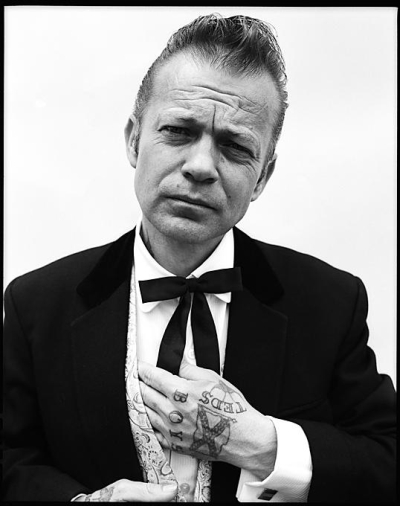
The main adepts of Rockabilly founded a new movement called Rockabilly Rebels (Rockabilly Rebs). Some of them embraced the politics of the British National Front and of racial segregation. They wore the Confederate flag. Teds News do not support this "movement" which is nearly dead ! Artists as Matchbox and Ray Campi, musical leaders of the Rockabilly Rebels were not at all racialist.
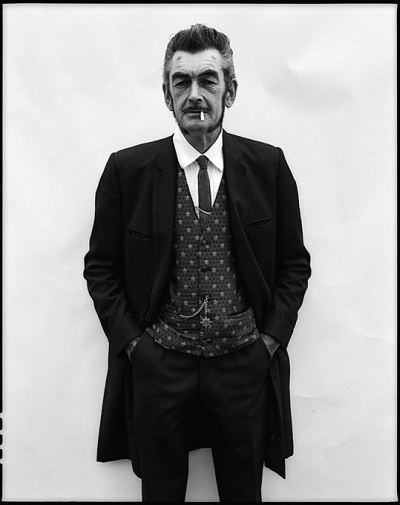
In the early 70's, a lot of Teds (particularly, the old generation) didn't care about Rockabilly, they asked for Rock'N'Roll. Nowadays, it's different : Rockabilly (with 50's R'N'R, instrumentals of the early 60's, Jumpin' Jive, Country Music) belongs to the Teds' culture.

The interest for Rockabilly coincided with the internationalisation of the Teddy Boy's tradition. New bands like Crazy Cavan & the Rhythm Rockers, the Flying Saucers, the Riot Rockers (...) exported all over Europe their own songs, their own music. They created a new sound that we 're still calling British Rockabilly. Some Teds prefer to use the term (Rockabilly) Revival. Teds News would like to promote this European sound also called Teddy Boy Rock'n'Roll, which had many supporters in the 70's and still have many fans in Europe even if a lot of (pseudo) purists hate this style that is not enough 50's for them. British Rockabilly can be played with an electric bass. The purists abhor this instrument, they prefer the double-bass ("slap bass").
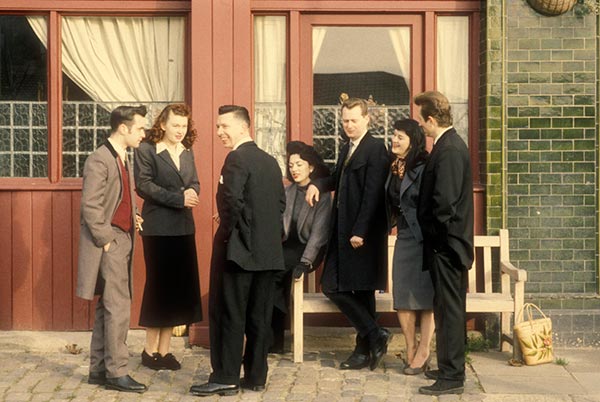
Teds News decided to support Teddy Boy R'N'R (even is this music is often underestimated), British R'N'R and bands that try to revive the early 60's instrumentals.
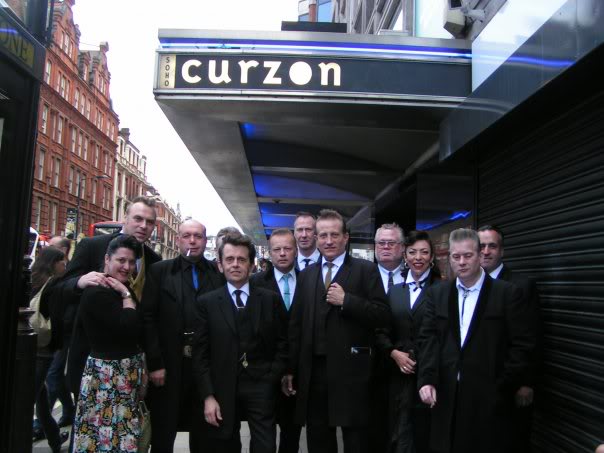
It seems that some Teds today return to the roots of their movement. They give up the 70's style for the 50's one. Nobody knows what the future will be. But we are sure that Rock'n'Roll will never die.
(Unknown author)

Coshes, Chains and Razors
Early in the decade, Britain produced the first Teddy Boys, regarded as the urban, unskilled working class boys, looking for an identity through the clothes they wore. They pursued gang warfare and vandalism in both the streets and the dance halls, carrying coshes, bicycle chains, razors and flick-knives beneath their fine Edwardian style clothes. The 50's was the first decade to produce teenage fashions, before this they were expected to dress similar to their parents. Following the war, when prosperity hit Britain, these working class teenagers could afford to buy their own clothes, although most shops only offered 'off the peg' conventional styles and many tailors refused to make up these 'new' fashions. The teenagers were now a marketing target that made 50's fashion a symbol of a whole new lifestyle.
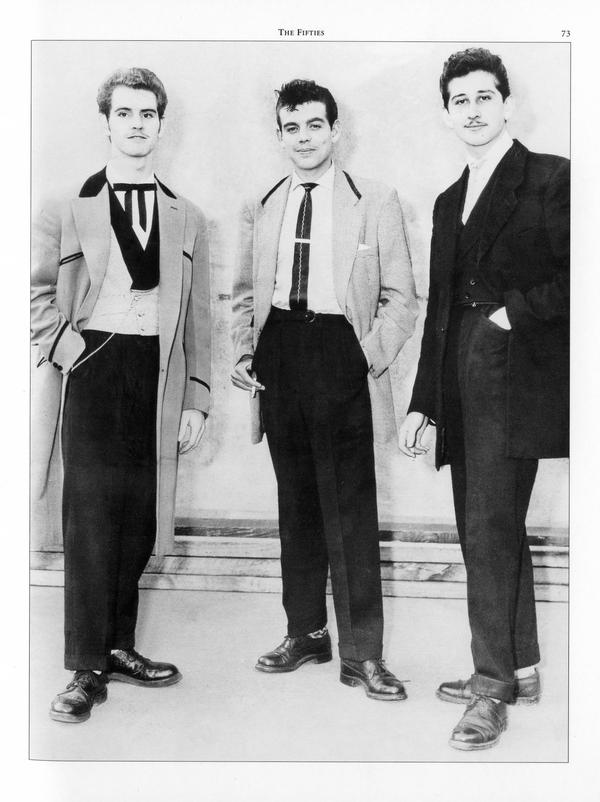
The association between these youths, their dance music, their clothes and crime, had become a major source of concern well before 1954 when a gang of Teds murdered a youth on Clapham Common.

The teddy boy uniform was originally copied from the smart Edwardian gentleman - their 'social superiors'. The style was tailored, and featured long high necked jackets, sometimes of velvet, or velvet trimmed collar and cuffs, and were lined in either floral or bright colours. This was worn with brocade waistcoats, bootlace or slim jim tie, narrow 'drainpipe' trousers, wing-collared shirts and suede shoes, which were originally regarded as 'gay men's shoes' or 'nancy boy shoes'. An essential accessory, along with the cycle chain was the comb. These new 'Edwardians' were not the respectable working class, and as a result the middle class who had pioneered the style, felt that their wardrobe had now become unwearable. Those who now wore the style were described as 'delinquents', 'zoot-suiters' and 'spivs'.
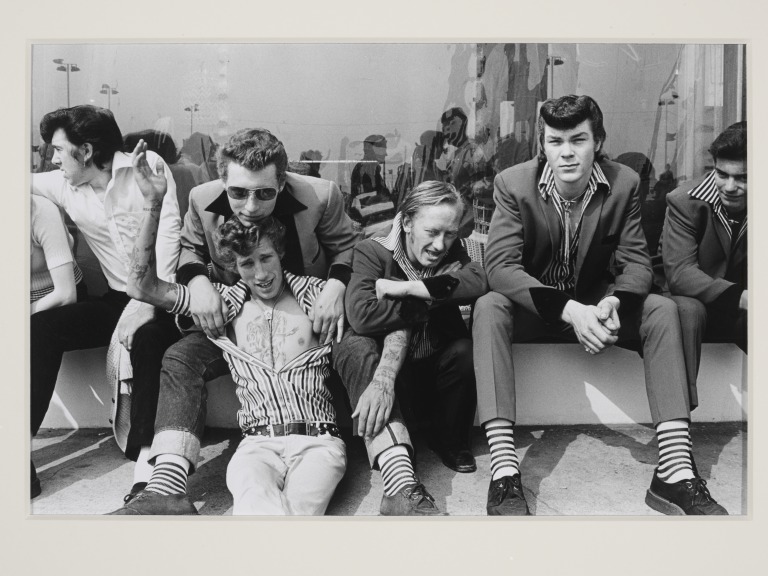
In the States, following Brando in the film 'The Wild One' the teenagers adapted their fashions accordingly, buying leather bomber jackets from War Surplus stores. As this film was banned in most towns in Britain at the time, the British missed out on this style until Gene Vincent, who already had a conviction for Public Lewdness and Obscenity in the States, flew over for a British TV show.
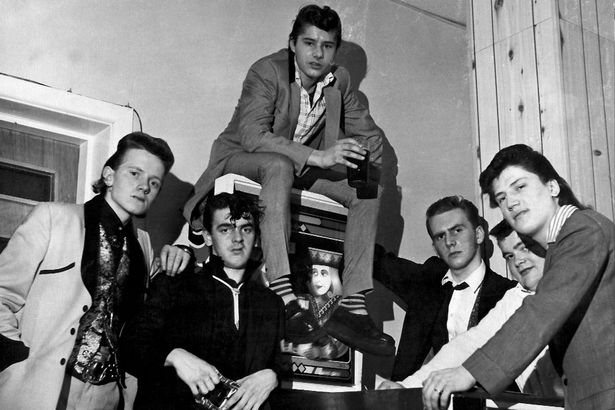
All teddy boys went to great pain to keep their hair in place. Fighting messed up the hair - hence the ever present metal comb. The DA was the main style although there were many variations such as 'the bop', 'the Tony Curtis', 'the be-bop', 'the tevee', 'the panama' or the 'back sweep and crest'. It was greased and usually accompanied by sideboards.
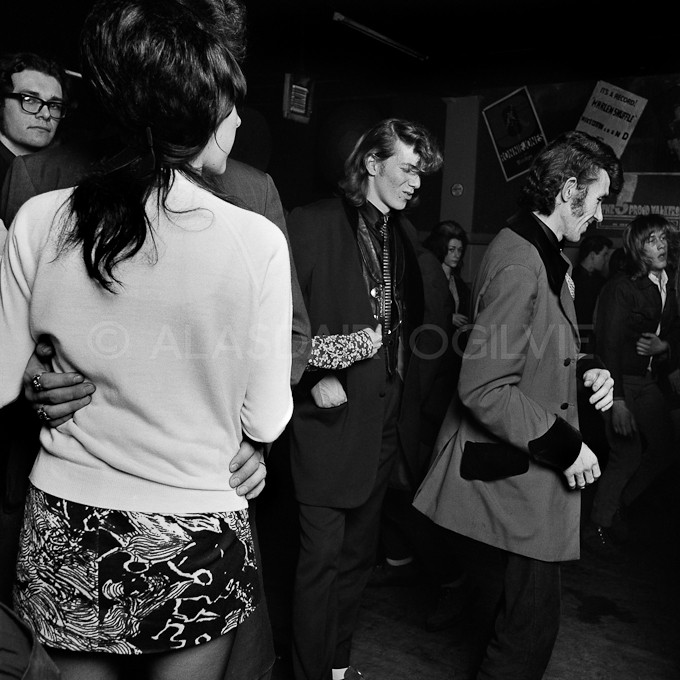
As the fifties went on the urban working class association with the 'Teddy Boy' dress spread further a field and with the commercial success of films like 'Rock Around The Clock' and resultant media attention it became the style of the fifties for not just the working class. Anyone causing trouble of any kind was blamed on Teddy Boys. Just as all health problems today are blamed on 'smokers', it became almost fashionable (and it sold papers) to blame any unsocial crime on 'Teddy Boys'. A youth only had to have a Tony Curtis haircut and he was instantly labelled 'a Teddy Boy'.
The Story Of The Teddy Boy Movement
All began in the early 1950's in England. Some teenagers gangs appeared in the East End of London; they were called the Cosh boys. It was very easy to recognise them. They wore a very special rig : long jacket with velvet collar and cuffs drain-pipe trousers like under the reign of Edward VII (1901-1910), bright ankle socks and slim Jim tie. There hair were "long" and greased. These Cosh boys terrified the English society : razor attacks, fights between gangs but also against the police, robberies ... After the Second World War England woke up with an headache ! Press needed a new term to describe these gangs which number increased each day? The word chosen was Teddy Boy(s) and Teddy Girl(s), Ted(s)

It seems that the first newspaper that used the term Teddy Boy was the Daily Express on September 23rd 1953. At this epoch, Elvis Presley was just a truck-driver!
And then, came Rock'n'Roll immediately adopted by the young generation and of course by the Teds. Bill Haley, Elvis, Buddy Holly, Eddie Cochran, Gene Vincent, Jerry Lee Lewis, Little Richard, Chuck Berry, and British artists like Tommy Steele, Cliff Richard and the Drifters (then the Shadows), Billy Fury, Marty Wilde (and many many others ... ) became the teenagers' idols. It was the beginning of something new, a wind of freedom. In Britain, in September 1956, Bill Haley had 5 records in the 'Top 20' and the film Rock Around The Clock was shown at 300 cinemas, but, in the early 60's, the tastes of the public changed and many Teds, after the military service in the British Army, put away their finger-tip drapes, their tightly fitting trousers and cut their hair. Was it the end of the Teds' culture ? Not at all ladies and gents!

50's R'N'R still had many fans in Great Britain ; many of them, the (Ton-Up) Rockers wore the "uniform" of the "American bad boys" : black leather jackets, T-shirts, jeans and motorcycle boots.
In 1967, Bill Haley's Shake, Rattle and Roll crept into the British charts again. At the end of the 60's, some bands played authentic R'N'R for a new generation of Teds which joined the original ones . Bands like the Wild Angels, the Houseshakers, the R'N'R Gang (in France), Shakin' Stevens & the Sunsets, the R'NR Allstars recreated the true spirit of R'N'R ; they rendered the big success of the 50's (',Johnny B. Goode',' Little Queenie'. 'Tutti Frutti','Peggy Sue', 'Be Bop A Lula, 'C'mon Everybody', 'Summertime Blues', 'Great Balls Of Fire', ...). This return to the traditional R'N'R was called Rock'n'Roll Revival.

In the 70's, the new generation of Teds developed a strong identity : hair lacquer started to replace grease, the drapes were brighter and, sometimes, the drain-pipes were tighter. Gradually , this new generation discovered one of the roots of R'N'R : Rockabilly and Country Music. Remember, Mr. Presley started off on Rockabilly! People like Carl Perkins, Johnny & Dorsey Burnette, Charlie Feathers, Hank Mizell, Warren Smith, Billy Lee Riley, Charlie Rich, George Jones, Carl Mann, Hayden Thomson, Janis Martin, Wanda Jackson, Sleepy Labeef (and many many other artists) became suddenly famous in England then soon after in the rest of Europe. In the same time, in the U.S.A., the great label Rollin' Rock recorded brilliant artists as Ray Campi, Mac Curtis ...

The main adepts of Rockabilly founded a new movement called Rockabilly Rebels (Rockabilly Rebs). Some of them embraced the politics of the British National Front and of racial segregation. They wore the Confederate flag. Teds News do not support this "movement" which is nearly dead ! Artists as Matchbox and Ray Campi, musical leaders of the Rockabilly Rebels were not at all racialist.

In the early 70's, a lot of Teds (particularly, the old generation) didn't care about Rockabilly, they asked for Rock'N'Roll. Nowadays, it's different : Rockabilly (with 50's R'N'R, instrumentals of the early 60's, Jumpin' Jive, Country Music) belongs to the Teds' culture.

The interest for Rockabilly coincided with the internationalisation of the Teddy Boy's tradition. New bands like Crazy Cavan & the Rhythm Rockers, the Flying Saucers, the Riot Rockers (...) exported all over Europe their own songs, their own music. They created a new sound that we 're still calling British Rockabilly. Some Teds prefer to use the term (Rockabilly) Revival. Teds News would like to promote this European sound also called Teddy Boy Rock'n'Roll, which had many supporters in the 70's and still have many fans in Europe even if a lot of (pseudo) purists hate this style that is not enough 50's for them. British Rockabilly can be played with an electric bass. The purists abhor this instrument, they prefer the double-bass ("slap bass").

Teds News decided to support Teddy Boy R'N'R (even is this music is often underestimated), British R'N'R and bands that try to revive the early 60's instrumentals.

It seems that some Teds today return to the roots of their movement. They give up the 70's style for the 50's one. Nobody knows what the future will be. But we are sure that Rock'n'Roll will never die.
(Unknown author)

Coshes, Chains and Razors
Early in the decade, Britain produced the first Teddy Boys, regarded as the urban, unskilled working class boys, looking for an identity through the clothes they wore. They pursued gang warfare and vandalism in both the streets and the dance halls, carrying coshes, bicycle chains, razors and flick-knives beneath their fine Edwardian style clothes. The 50's was the first decade to produce teenage fashions, before this they were expected to dress similar to their parents. Following the war, when prosperity hit Britain, these working class teenagers could afford to buy their own clothes, although most shops only offered 'off the peg' conventional styles and many tailors refused to make up these 'new' fashions. The teenagers were now a marketing target that made 50's fashion a symbol of a whole new lifestyle.

The association between these youths, their dance music, their clothes and crime, had become a major source of concern well before 1954 when a gang of Teds murdered a youth on Clapham Common.

The teddy boy uniform was originally copied from the smart Edwardian gentleman - their 'social superiors'. The style was tailored, and featured long high necked jackets, sometimes of velvet, or velvet trimmed collar and cuffs, and were lined in either floral or bright colours. This was worn with brocade waistcoats, bootlace or slim jim tie, narrow 'drainpipe' trousers, wing-collared shirts and suede shoes, which were originally regarded as 'gay men's shoes' or 'nancy boy shoes'. An essential accessory, along with the cycle chain was the comb. These new 'Edwardians' were not the respectable working class, and as a result the middle class who had pioneered the style, felt that their wardrobe had now become unwearable. Those who now wore the style were described as 'delinquents', 'zoot-suiters' and 'spivs'.

In the States, following Brando in the film 'The Wild One' the teenagers adapted their fashions accordingly, buying leather bomber jackets from War Surplus stores. As this film was banned in most towns in Britain at the time, the British missed out on this style until Gene Vincent, who already had a conviction for Public Lewdness and Obscenity in the States, flew over for a British TV show.

All teddy boys went to great pain to keep their hair in place. Fighting messed up the hair - hence the ever present metal comb. The DA was the main style although there were many variations such as 'the bop', 'the Tony Curtis', 'the be-bop', 'the tevee', 'the panama' or the 'back sweep and crest'. It was greased and usually accompanied by sideboards.

As the fifties went on the urban working class association with the 'Teddy Boy' dress spread further a field and with the commercial success of films like 'Rock Around The Clock' and resultant media attention it became the style of the fifties for not just the working class. Anyone causing trouble of any kind was blamed on Teddy Boys. Just as all health problems today are blamed on 'smokers', it became almost fashionable (and it sold papers) to blame any unsocial crime on 'Teddy Boys'. A youth only had to have a Tony Curtis haircut and he was instantly labelled 'a Teddy Boy'.
_________________
We don't care the People Says , Rock 'n' roll is here to stay - Danny & the Juniors - 1958
 Re: Teddy Boys
Re: Teddy Boys
_________________
We don't care the People Says , Rock 'n' roll is here to stay - Danny & the Juniors - 1958
 Re: Teddy Boys
Re: Teddy Boys
_________________
We don't care the People Says , Rock 'n' roll is here to stay - Danny & the Juniors - 1958
 Re: Teddy Boys
Re: Teddy Boys
_________________
We don't care the People Says , Rock 'n' roll is here to stay - Danny & the Juniors - 1958
 Re: Teddy Boys
Re: Teddy Boys
_________________
We don't care the People Says , Rock 'n' roll is here to stay - Danny & the Juniors - 1958
 Re: Teddy Boys
Re: Teddy Boys
Here's a great clip of 1950's Teddy Boy being interveiwed by a News Reporter about an attack on a Vicar.It seems Teddy Boys disappear in the Summer & all go Fishing!We only come out in the Winter when it's dark to do Evil deeds!Hilarious!
8-Ball Paul
_________________
We don't care the People Says , Rock 'n' roll is here to stay - Danny & the Juniors - 1958
 Re: Teddy Boys
Re: Teddy Boys
_________________
We don't care the People Says , Rock 'n' roll is here to stay - Danny & the Juniors - 1958
 Re: Teddy Boys
Re: Teddy Boys
_________________
We don't care the People Says , Rock 'n' roll is here to stay - Danny & the Juniors - 1958
 1955 pics of Teddy Girl's
1955 pics of Teddy Girl's
_________________
We don't care the People Says , Rock 'n' roll is here to stay - Danny & the Juniors - 1958
 Re: Teddy Boys
Re: Teddy Boys
_________________
We don't care the People Says , Rock 'n' roll is here to stay - Danny & the Juniors - 1958
 Re: Teddy Boys
Re: Teddy Boys
_________________
We don't care the People Says , Rock 'n' roll is here to stay - Danny & the Juniors - 1958
 Re: Teddy Boys
Re: Teddy Boys
_________________
We don't care the People Says , Rock 'n' roll is here to stay - Danny & the Juniors - 1958
 Re: Teddy Boys
Re: Teddy Boys
_________________
We don't care the People Says , Rock 'n' roll is here to stay - Danny & the Juniors - 1958
 Re: Teddy Boys
Re: Teddy Boys
_________________
We don't care the People Says , Rock 'n' roll is here to stay - Danny & the Juniors - 1958
 Re: Teddy Boys
Re: Teddy Boys
_________________
We don't care the People Says , Rock 'n' roll is here to stay - Danny & the Juniors - 1958
 Re: Teddy Boys
Re: Teddy Boys
_________________
We don't care the People Says , Rock 'n' roll is here to stay - Danny & the Juniors - 1958
 Re: Teddy Boys
Re: Teddy Boys
The Teddy Boys of the Edwardian Drape Society 1996
_________________
We don't care the People Says , Rock 'n' roll is here to stay - Danny & the Juniors - 1958
 Re: Teddy Boys
Re: Teddy Boys
_________________
We don't care the People Says , Rock 'n' roll is here to stay - Danny & the Juniors - 1958
 Re: Teddy Boys
Re: Teddy Boys
_________________
We don't care the People Says , Rock 'n' roll is here to stay - Danny & the Juniors - 1958
 Re: Teddy Boys
Re: Teddy Boys
_________________
We don't care the People Says , Rock 'n' roll is here to stay - Danny & the Juniors - 1958
Page 1 sur 6 • 1, 2, 3, 4, 5, 6 
 Sujets similaires
Sujets similaires» Documentary 1972 - Teddy Boys
» General Lee & Teddy Boys - paris 13éme 1979
» Vidéo Teddy Boys in London Club - 1977
» Sex Pistols - Malcolm McLarren, Rock'n'roll to punk - Teddy boys and Punk Rockers et shop Let it Rock
» The Teds - Chris Steele-Perkins & Richard Smith - Photographie Teddy boys late 70s early 80s
» General Lee & Teddy Boys - paris 13éme 1979
» Vidéo Teddy Boys in London Club - 1977
» Sex Pistols - Malcolm McLarren, Rock'n'roll to punk - Teddy boys and Punk Rockers et shop Let it Rock
» The Teds - Chris Steele-Perkins & Richard Smith - Photographie Teddy boys late 70s early 80s
Page 1 sur 6
Permission de ce forum:
Vous ne pouvez pas répondre aux sujets dans ce forum
 Connexion
Connexion

